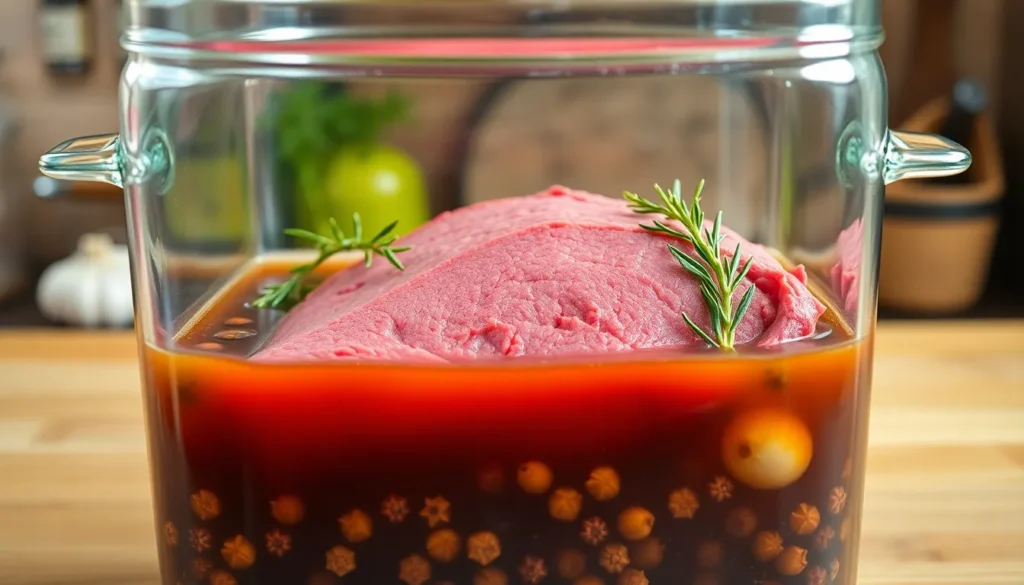There’s nothing quite like the tender, flavorful magic that happens when we transform a tough cut of beef into melt-in-your-mouth corned beef through the ancient art of brining. This time-honored preservation technique doesn’t just cure the meat – it infuses every fiber with a perfect balance of salt, spices, and aromatic herbs that’ll make your kitchen smell absolutely incredible.
We’ve perfected this traditional corned beef brine recipe that turns an ordinary beef brisket into something extraordinary. The secret lies in the careful blend of pickling spices, pink curing salt, and just the right amount of time to work its magic. Whether you’re planning ahead for St. Patrick’s Day or simply craving that distinctive corned beef flavor year-round, this homemade brine delivers restaurant-quality results every single time.
Ready to discover why making your own corned beef beats store-bought every time? Let’s jump into this foolproof brining process that’ll have you wondering why you ever bought pre-made corned beef again.
What Is Corned Beef Brine
Corned beef brine is a carefully balanced salt solution that transforms tough cuts of beef into tender and flavorful meat through the process of curing. We create this magical liquid by combining water with coarse salt, sugar, and pink curing salt (sodium nitrite) along with aromatic spices that give corned beef its distinctive taste.
The brining process works by drawing moisture from the meat while simultaneously infusing it with salt and spices. This dual action breaks down tough muscle fibers and creates the characteristic pink color we associate with corned beef. Pink curing salt plays a crucial role in this transformation by preventing harmful bacteria growth and maintaining that appealing rosy hue throughout the curing period.
Our brine recipe typically includes pickling spices such as coriander seeds, mustard seeds, bay leaves, allspice berries, and peppercorns. These spices penetrate deep into the meat during the extended brining time, creating complex layers of flavor that distinguish homemade corned beef from store-bought versions.
The salt concentration in corned beef brine must be precise to ensure proper curing without over-salting the meat. We maintain a ratio that allows the brine to work effectively over several days, gradually transforming the beef brisket into the tender and savory corned beef we crave. This time-tested preservation method has been used for centuries to create one of the most beloved comfort foods in American cuisine.
Sugar balances the saltiness while helping to develop the meat’s color and flavor profile. The combination of salt, sugar, and curing salt creates an environment where beneficial curing reactions can occur while preventing spoilage during the multi-day process.
Essential Equipment for Brining
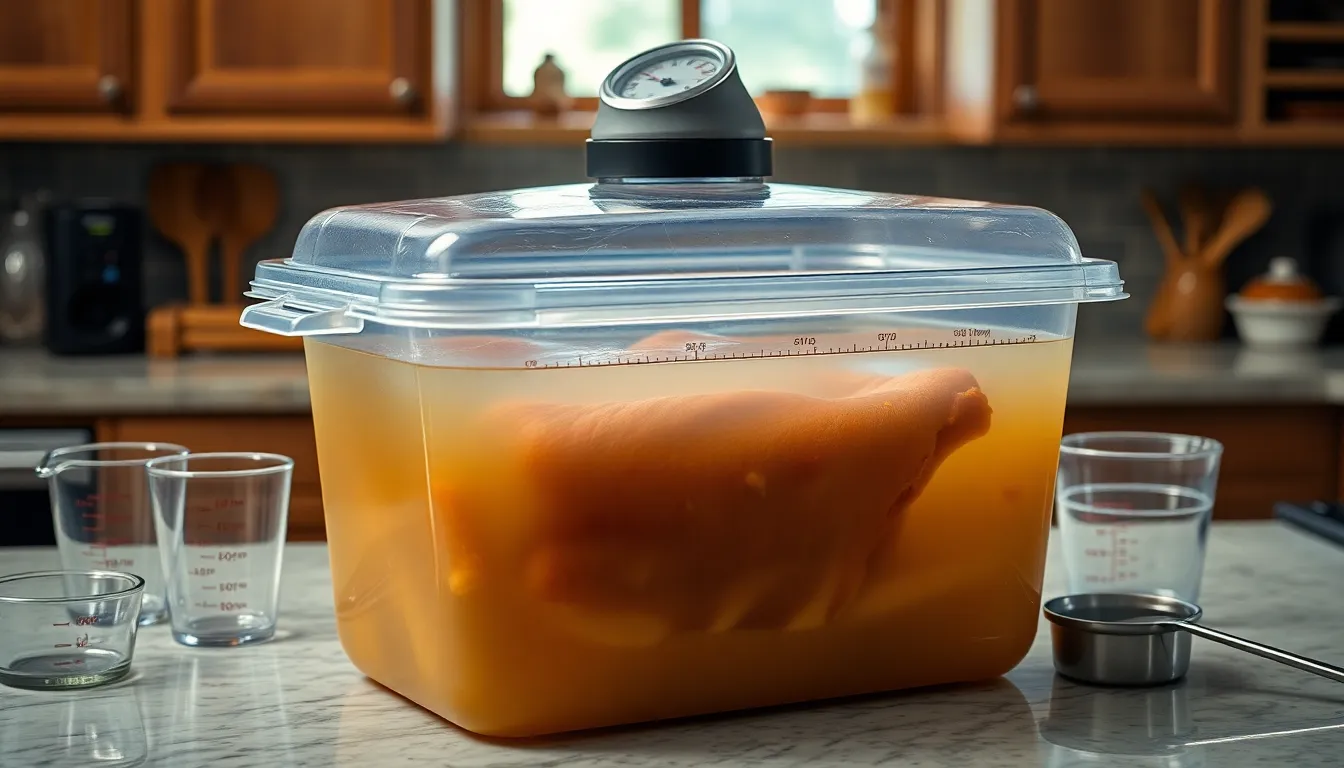
Success in creating perfect corned beef depends heavily on having the right equipment before we begin our brining journey. We need exact tools to ensure our brisket stays properly submerged and safely cured throughout the multi-day process.
Large container or pot serves as our foundation for the entire brining operation. We recommend using a large Dutch oven or food-grade plastic container that can accommodate both our 5-pound brisket and sufficient brine to cover it completely. The container must provide enough space for the meat to float freely while remaining fully submerged.
Weight or plate becomes essential for keeping our brisket beneath the brine surface. We place this directly on top of the meat to prevent any portions from floating above the liquid where harmful bacteria could develop. Air exposure during brining can compromise both safety and flavor development.
Refrigeration space capable of maintaining temperatures between 34°F and 40°F (1°C to 4°C) protects our investment throughout the 5 to 7 day brining period. We must ensure adequate room in our refrigerator to accommodate the large container without disrupting proper air circulation.
Measuring spoons and cups guarantee precision in our brine formulation. Accurate measurements of our ½ to 2 cups kosher salt, ¼ to ½ cup sugar, and 2 to 5 teaspoons pink curing salt determine the success of our entire project.
Stove or heat source allows us to properly dissolve our salts and sugar while activating our pickling spices. We use this equipment to bring our brine mixture to a rolling boil before cooling it completely.
Thermometer helps us monitor brine temperature as we cool it to the optimal 45°F (7°C) before introducing our brisket. This optional tool ensures we protect the meat from temperature shock while maintaining food safety standards.
| Equipment | Purpose | Temperature Range |
|---|---|---|
| Large container | Hold brisket and brine | N/A |
| Weight/plate | Keep meat submerged | N/A |
| Refrigeration | Maintain safe temperatures | 34°F – 40°F (1°C – 4°C) |
| Thermometer | Monitor brine cooling | Target: 45°F (7°C) |
Additional cooking equipment becomes necessary after our brining process concludes. We prepare a large pot or slow cooker for the final simmering stage that transforms our cured brisket into tender corned beef ready for serving.
Ingredients
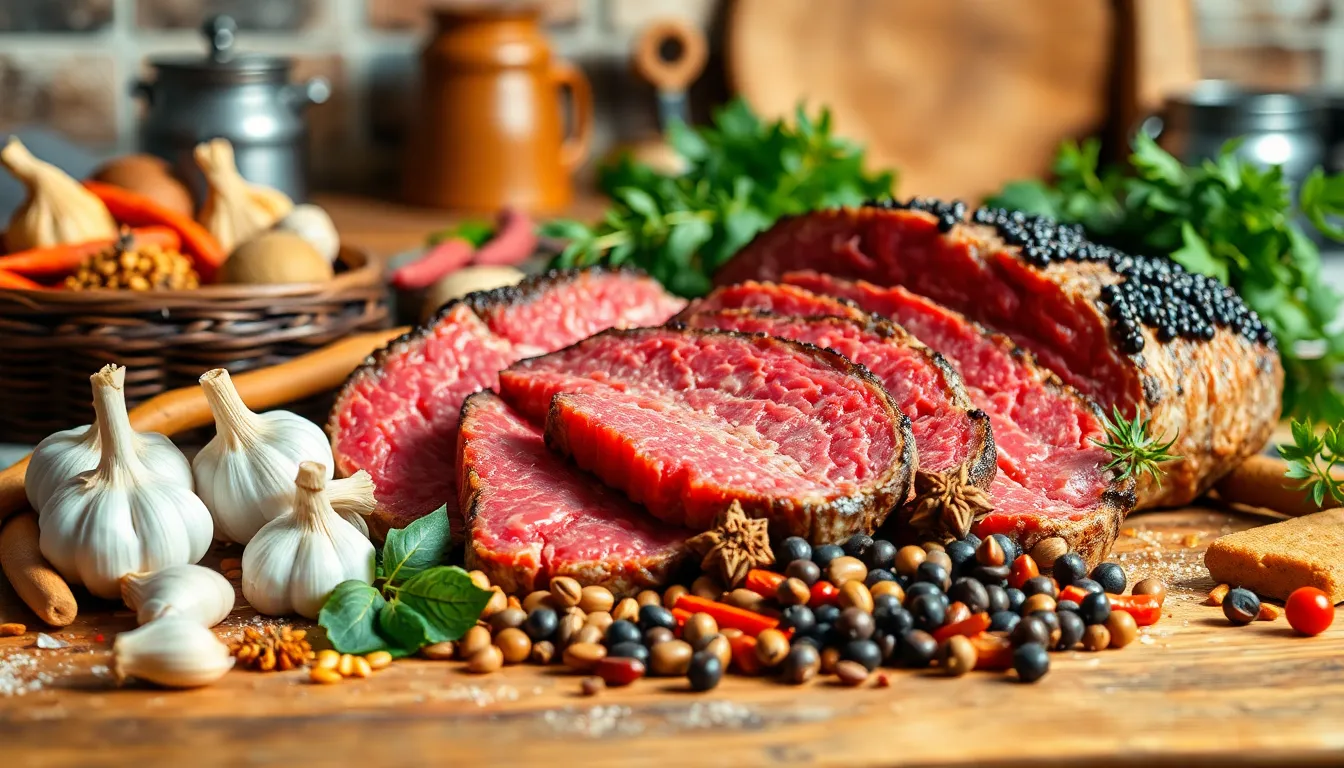
Our corned beef brine recipe requires exact ingredients in precise measurements to achieve that perfect balance of saltiness and aromatic spices. We’ve organized the ingredients into two categories to make preparation straightforward and ensure you have everything ready before starting the brining process.
For the Brine
- Water: 1 gallon (approximately 3.8 liters) of clean, cool water
- Pink curing salt #1 (Prague Powder #1): 4 oz (approximately 4-5 teaspoons) — contains sodium nitrite for proper curing
- Kosher salt: 8 oz (about ½ cup) — use kosher salt for accurate measurement
- Brown sugar: ½ cup (light or dark brown sugar works well)
- Garlic cloves: 10 cloves, peeled and ready to use
- Whole allspice berries: 1 tablespoon
- Whole mustard seeds: 1 tablespoon
- Coriander seeds: 1 tablespoon
- Red pepper flakes: ½ tablespoon
- Whole black peppercorns: 1 tablespoon
- Whole red peppercorns: 1 tablespoon
- Whole cloves: 1 teaspoon
- Whole cardamom pods: 8 pods
- Bay leaves: 6 large leaves, crumbled
- Ground ginger: 2 teaspoons
- Cinnamon stick: 1 stick, broken into pieces
For the Corned Beef
- Beef brisket: 5 lbs (about 2.3 kg), trimmed to your preference before brining begins
Instructions
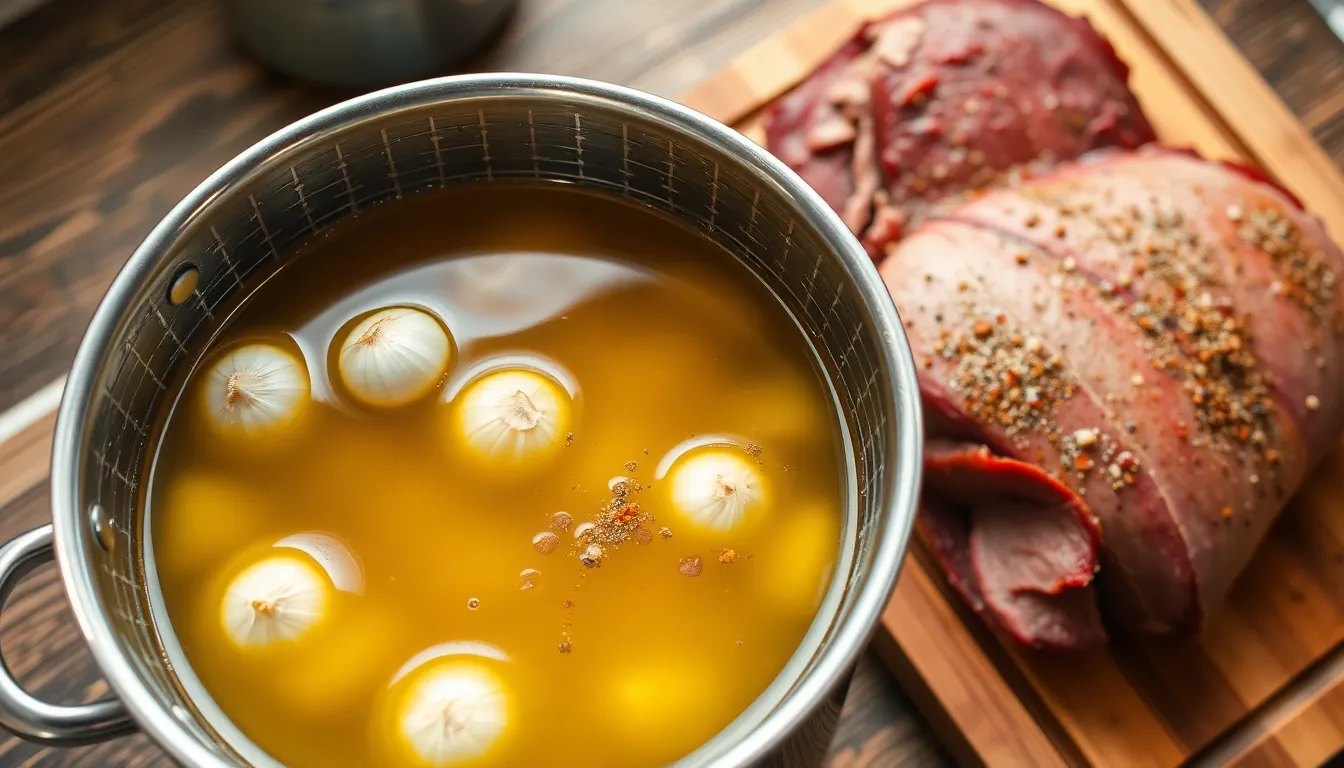
Creating perfect corned beef brine requires precise timing and attention to detail. We’ll guide you through each step to ensure your brisket transforms into tender flavorful corned beef.
Prep the Brine
Combine 1 gallon of water with kosher salt pink curing salt and brown sugar in a large pot or Dutch oven. Heat the mixture while stirring continuously until all salts and sugar dissolve completely. Add garlic cloves and half of your pickling spice blend to the pot. Bring the mixture to a rolling boil for 2-3 minutes to fully infuse the aromatic spices into the liquid.
Remove the pot from heat immediately after boiling. Allow the brine to cool completely to refrigerator temperature around 45°F before proceeding. Speed up the cooling process by placing the pot in an ice bath or transferring the brine to a shallow container for faster heat dissipation.
Prepare the Beef
Select a quality 5-pound beef brisket from your butcher or grocery store. Trim excess fat from the surface while leaving approximately ¼ inch of fat to maintain moisture during the long brining and cooking process. Rinse the brisket thoroughly under cold running water to remove any surface debris.
Pat the meat completely dry with paper towels before placing it into the cooled brine solution. Examine the brisket for any remaining blood spots or bone fragments that may need removal.
Brining Process
Submerge the prepared brisket fully into the cooled brine solution using a large food-safe container or non-reactive pot. Place a clean plate or weighted object directly on top of the meat to keep it completely submerged throughout the brining period. Cover the entire container with plastic wrap or a tight-fitting lid.
Refrigerate the brining brisket for 5 to 7 days maintaining a consistent temperature below 40°F. Turn the brisket every 2 days to ensure even distribution of flavors and proper curing throughout the meat. Check that the meat remains fully submerged adding more brine solution if necessary.
After Brining
Remove the cured brisket from the brine and discard the used brining liquid completely. Rinse the corned beef thoroughly under cold running water for several minutes to remove excess surface salt. Pat the meat dry with clean paper towels before proceeding to cook.
Place the rinsed corned beef in a large pot with fresh water and the remaining pickling spices. Simmer the meat gently for 3 to 4 hours until it reaches fork-tender consistency. Slice the finished corned beef against the grain using a sharp knife for maximum tenderness and optimal texture.
Directions for Cooking Your Brined Corned Beef

After your brisket has completed its 5 to 7 day brining journey, we’re ready to transform it into tender, flavorful corned beef. Three proven cooking methods deliver exceptional results, each offering unique advantages for your kitchen setup and schedule.
Stovetop Method
Remove the brisket from the brine and rinse thoroughly under cold running water to eliminate excess salt. Place the meat in a large pot and cover completely with fresh water or beef broth. Add a fresh tablespoon of pickling spices to enhance the aromatic profile during cooking.
Bring the liquid to a rolling boil over high heat, then immediately reduce to a gentle simmer. Cover the pot and maintain this low simmer for approximately 3 hours, checking periodically to ensure the meat remains submerged. The brisket reaches perfect doneness when a fork easily pierces the thickest section.
Allow the cooked corned beef to rest for 10 minutes before transferring to a cutting board. Slice against the grain in thin, even cuts to maximize tenderness and preserve the meat’s beautiful texture.
Slow Cooker Method
Place the rinsed and drained corned beef brisket into your slow cooker, positioning it fat side up for optimal moisture retention. Pour 4 cups of water or beef broth around the meat, ensuring the liquid reaches halfway up the sides of the brisket.
| Cooking Time | Temperature Setting | Results |
|---|---|---|
| 8-10 hours | LOW | Maximum tenderness |
| 4-5 hours | HIGH | Faster cooking |
Set your slow cooker to LOW for 8 to 10 hours or HIGH for 4 to 5 hours until the meat becomes fork tender. This hands off approach allows you to add traditional vegetables like cabbage wedges and quartered potatoes during the final 2 hours of cooking for a complete meal.
Test doneness by gently pulling the meat with two forks. Properly cooked corned beef should shred easily while maintaining its structure.
Oven Method
Preheat your oven to 300°F for gentle, even cooking that prevents the meat from drying out. Place the rinsed brisket in a heavy roasting pan or Dutch oven with a tight fitting lid. Add 1 to 2 cups of water or beef broth to create steam that keeps the meat moist throughout the cooking process.
Cover the pan tightly with aluminum foil, then secure the lid to create a sealed cooking environment. Bake for 3 to 4 hours, checking occasionally to ensure the liquid hasn’t evaporated completely. Add more broth if needed to maintain moisture levels.
The corned beef is ready when it reaches an internal temperature of 190°F to 205°F, measured with a meat thermometer inserted into the thickest portion. Rest the meat for 15 minutes before slicing to allow juices to redistribute throughout the fibers.
Make-Ahead Instructions

Planning ahead transforms corned beef preparation from a last-minute scramble into a well-orchestrated culinary event. We recommend starting your brine preparation up to a week before you plan to serve the finished corned beef.
Preparing the Brine in Advance
The brine solution stores beautifully in your refrigerator for several days before use. We suggest making the brine 1 to 2 days ahead of when you plan to begin the curing process. This approach allows all the flavors to meld together while giving you flexibility in your cooking schedule.
Store the cooled brine in a covered container or large pitcher in your refrigerator. The salt and sugar will remain fully dissolved and the spices will continue developing their aromatic qualities during this storage period.
Optimal Brining Timeline
Your beef brisket requires 5 to 7 days in the brine for proper curing and flavor development. We cannot stress enough how important this timing becomes for achieving authentic corned beef results. The curing process needs this full duration to break down the muscle fibers and infuse the meat with those distinctive flavors.
Mark your calendar with these key dates when planning your corned beef project:
| Timeline Component | Days Before Serving | Action Required |
|---|---|---|
| Brine Preparation | 8-9 days | Mix and cool brine completely |
| Begin Brining | 7-8 days | Submerge brisket in brine |
| Daily Turning | 6-2 days | Flip brisket for even curing |
| Remove from Brine | 1 day | Rinse and prepare for cooking |
| Cooking Day | Day of serving | Cook using preferred method |
Maintaining Proper Brining Conditions
Daily attention during the brining period ensures even flavor distribution throughout your brisket. We flip the meat once each day to expose all surfaces to the curing solution equally. This simple step prevents any areas from remaining under-seasoned.
Keep your brining container in the coldest part of your refrigerator throughout the entire process. The temperature should remain consistently below 40°F to prevent any food safety concerns while the curing magic happens.
Storage Tips for Success
A plate or clean weight keeps your brisket completely submerged during the entire brining period. Air exposure can create uneven curing and potentially compromise food safety. We position the weight carefully to ensure every inch of meat stays below the brine surface.
Your brined brisket can remain in the solution for up to 10 days if needed without becoming overly salty. This flexibility allows you to adjust your cooking schedule based on your serving timeline or unexpected schedule changes.
Storage and Shelf Life
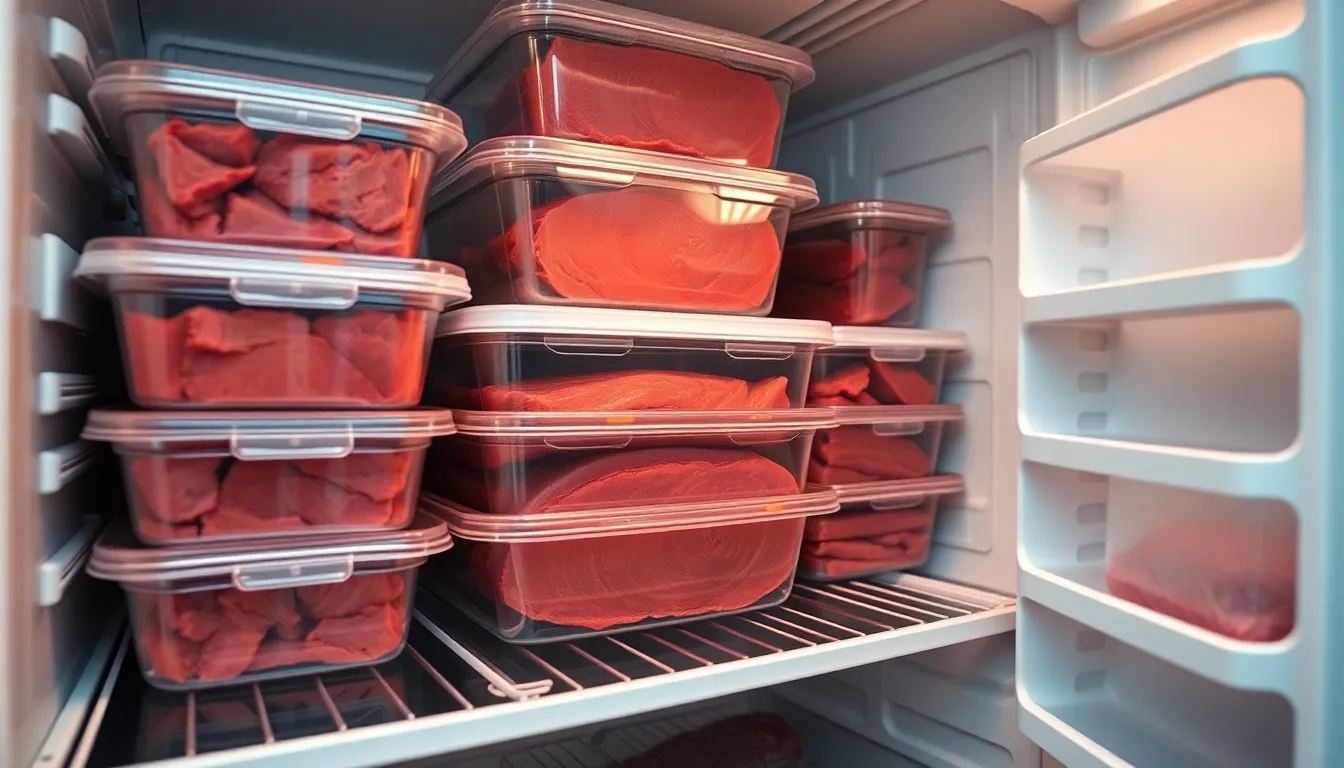
After dedicating time to create the perfect brine and cure our beef brisket, proper storage becomes essential for maintaining both safety and quality. We need to understand the different storage requirements for each stage of the corned beef process.
Our freshly brined beef requires careful attention during the initial storage period. After completing the 5 to 7 day brining process in the refrigerator at or below 40°F, we can extend storage in the same brine for an additional 1 to 2 weeks while maintaining proper refrigeration. The pink curing salt we added to our brine plays a crucial role here by reducing harmful bacteria growth during the extended brining period.
| Storage Type | Temperature | Duration |
|---|---|---|
| Freshly Brined Beef | ≤40°F (4°C) | 5-7 days + 1-2 weeks additional |
| Cooked Corned Beef | Refrigerated | 3-5 days |
| Frozen (Brined or Cooked) | 0°F (-18°C) | 2-3 months |
Once we cook our corned beef using any of the methods we discussed, storage requirements shift significantly. Cooked corned beef should be refrigerated immediately and consumed within 3 to 5 days for optimal freshness and safety.
Freezing offers us an excellent option for extending shelf life when we need longer storage. Both brined and cooked corned beef freeze well for up to 2 to 3 months. We must wrap the meat thoroughly to prevent freezer burn, which can compromise texture and flavor.
Temperature control remains our most critical factor throughout the entire storage process. Maintaining proper refrigeration at or below 40°F during brining and storage ensures food safety while preserving the quality we worked hard to achieve. The sodium nitrite in our pink curing salt continues to provide protection against harmful bacteria throughout the storage period, making our homemade corned beef both delicious and safe to consume.
Tips for Perfect Corned Beef Brine
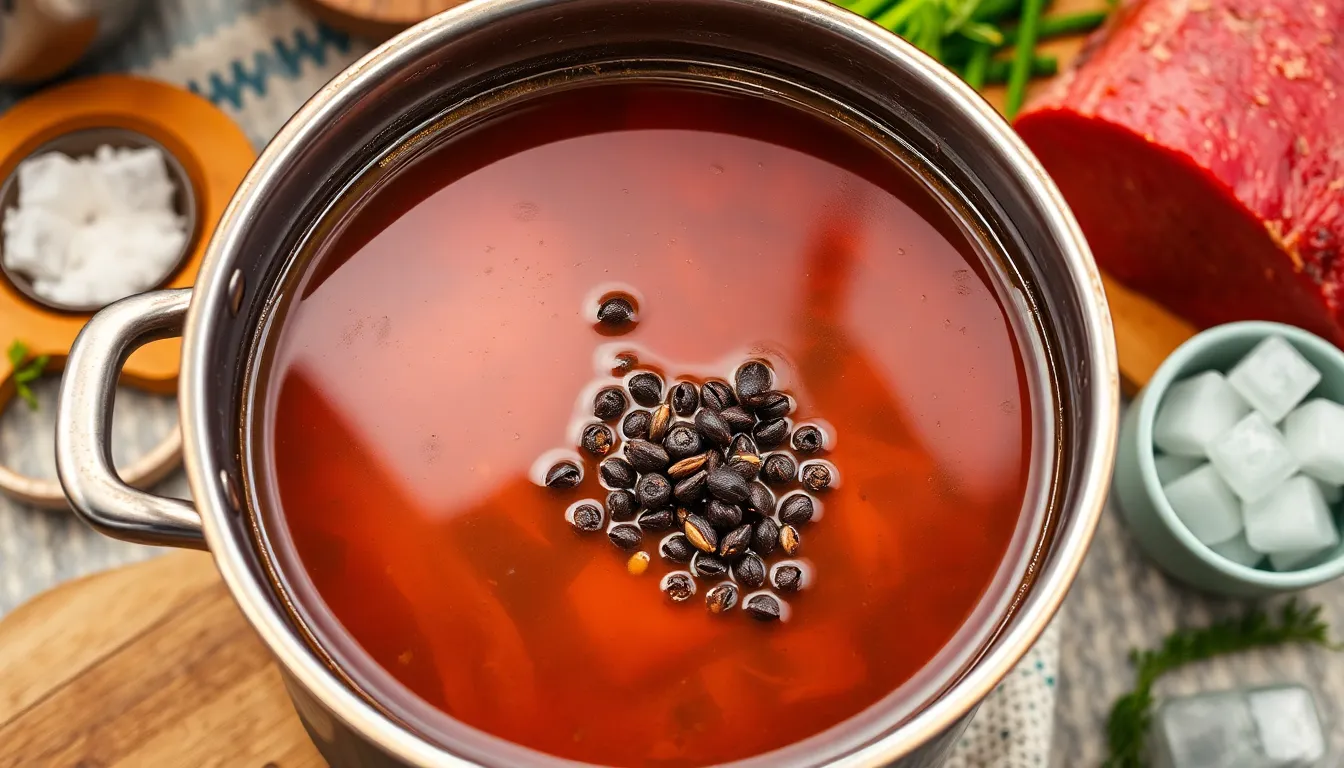
Creating exceptional corned beef starts with mastering the brining process. We’ve discovered that certain techniques make the difference between average and outstanding results.
Toast Your Spices First
Toasting whole spices in a dry pan before adding them to the brine releases their essential oils and intensifies flavor. We recommend heating black peppercorns, coriander seeds, mustard seeds, and allspice berries for 2-3 minutes until fragrant. This simple step transforms the entire flavor profile of your finished corned beef.
Never Skip Pink Curing Salt
Pink curing salt remains absolutely critical for both food safety and achieving that characteristic corned beef color. We use 2-5 teaspoons per gallon of water to prevent harmful bacteria growth while maintaining the meat’s appealing pink hue. Store-bought alternatives simply cannot match this essential ingredient.
Cool Your Brine Completely
Hot brine will begin cooking your brisket rather than curing it properly. We bring our brine mixture to a boil to dissolve the salts and sugar completely, then cool it to 45°F before adding the meat. Adding ice cubes speeds this process and ensures optimal curing conditions.
Keep the Meat Submerged
Brisket naturally wants to float, but exposed portions won’t cure evenly. We place a clean plate directly on top of the meat to keep it fully submerged throughout the brining period. This technique ensures consistent flavor penetration and proper curing.
Maintain Proper Fat Coverage
Leaving approximately ¼ inch of fat on the brisket keeps the meat moist during both brining and cooking. We trim excess fat but preserve this protective layer for better texture and flavor retention. Completely lean brisket tends to dry out during the extended cooking process.
Turn Daily for Even Curing
Flipping the brisket once daily ensures all surfaces receive equal exposure to the brine. We set a daily reminder to turn the meat, promoting uniform flavor distribution and consistent texture throughout the finished product.
Follow the Timing Guidelines
| Brining Duration | Result Quality |
|---|---|
| 3 days minimum | Basic flavor penetration |
| 5-7 days optimal | Deep flavor and ideal texture |
| Up to 10 days maximum | Intensely flavored without oversalting |
Rushing the process yields disappointing results, while proper timing creates restaurant-quality corned beef at home.
Rinse Before Cooking
We always rinse the brined brisket under cold running water to remove excess surface salt before cooking. This step prevents an overly salty final product while preserving the deep flavors that developed during curing.
Slice Against the Grain
After cooking, we slice the finished corned beef against the grain for maximum tenderness. Identifying the direction of the muscle fibers and cutting perpendicular to them makes even tough cuts incredibly tender and enjoyable.
Troubleshooting Common Issues

Even experienced home cooks occasionally encounter challenges when brining corned beef. We’ve compiled answers to the most common problems that arise during the brining process.
Shortened Brining Time
Sometimes life gets in the way and we realize our brisket hasn’t had the full 7-day brining period. When you only have 2-3 days available, pierce the meat surface with a blade tenderizer to create small channels that speed up brine absorption. Never increase the pink curing salt concentration to compensate for shorter brining time as this creates safety risks and causes uneven coloring throughout the meat.
Uneven Curing or Color Development
Patchy pink coloring or inconsistent flavor typically stems from inadequate submersion or improper salt ratios. We recommend weighing down the brisket with a heavy plate to ensure complete coverage throughout the brining period. Check daily that no portions of meat rise above the brine surface. Maintain the precise salt measurements outlined in our recipe since deviating from these ratios leads to poor curing results.
Brine Temperature Problems
Starting with overly hot brine can partially cook the meat surface while cold brine penetrates slowly. We suggest heating the brine ingredients until dissolved then rapidly cooling in an ice bath to approximately 45°F before adding the brisket. This temperature shock creates a partial vacuum effect that enhances brine penetration without compromising meat texture.
Metallic or Preservative Taste
Store-bought corned beef often carries an unpleasant metallic flavor from commercial preservatives. Our homemade brine recipe eliminates this issue by using only pink curing salt and natural spices. Toast your pickling spices briefly before adding them to the brine to maximize their aromatic compounds and mask any residual curing salt flavor.
Meat Not Staying Submerged
Large briskets tend to float even though our best efforts to weigh them down. Place the brisket in a large zip-top bag with the brine then remove excess air before sealing. This method ensures complete contact between meat and brine while taking up less refrigerator space. Alternatively, use a rigid container with a plate weighted down by a clean mason jar filled with water.
Brine Concentration Issues
Too much salt creates an overly salty final product while too little prevents proper curing. We measure salt by weight rather than volume for accuracy since different salt types have varying crystal sizes. Use a kitchen scale to measure 3 ounces of salt for every 4 cups of water to maintain the proper concentration for effective curing.
Conclusion
We’ve walked you through every aspect of creating exceptional homemade corned beef brine that’ll transform tough brisket into tender flavorful meat. With our detailed recipe proper equipment and proven techniques you’re equipped to produce restaurant-quality results in your own kitchen.
The beauty of this traditional preservation method lies in its flexibility – you can adjust the brining timeline to fit your schedule while maintaining consistent delicious outcomes. Whether you’re preparing for St. Patrick’s Day or simply craving comfort food throughout the year this foolproof process delivers every time.
Remember that patience is key to perfect corned beef. Allow the brine to work its magic over several days and you’ll be rewarded with incredibly tender meat that’s infused with aromatic spices. Your homemade version will surpass any store-bought alternative and become a treasured recipe in your culinary repertoire.
Frequently Asked Questions
What is corned beef brine?
Corned beef brine is a salt-based curing solution that transforms tough cuts of beef into tender, flavorful corned beef. It combines water, coarse salt, sugar, pink curing salt, and aromatic spices like coriander, mustard seeds, and bay leaves. This solution breaks down muscle fibers while infusing the meat with distinctive flavors and preserving it safely.
How long should I brine corned beef?
Brine corned beef for 5 to 7 days in the refrigerator, turning the meat daily for even flavor distribution. The brisket can safely remain in the brine for up to 10 days without becoming overly salty, giving you flexibility with your cooking schedule.
What equipment do I need for brining corned beef?
You’ll need a large container or pot to hold the brine and meat, a weight to keep the brisket submerged, and adequate refrigeration space. Ensure your container is food-safe and large enough to completely cover the meat with brine solution.
Can I make the brine ahead of time?
Yes, prepare the brine 1 to 2 days in advance to allow the flavors to meld properly. Store the prepared brine in the refrigerator and ensure it’s completely cooled before adding the meat to prevent bacterial growth.
What cooking methods work best for brined corned beef?
Three proven methods work well: stovetop simmering (3 hours), slow cooker (4-10 hours depending on setting), and oven braising at 300°F (3-4 hours). Each method produces tender, flavorful results when the internal temperature reaches 195-205°F.
How should I store homemade corned beef?
Freshly brined beef can stay in the brine for an additional 1-2 weeks after the initial brining period. Once cooked, refrigerate corned beef for 3-5 days or freeze for 2-3 months. Always maintain refrigeration at or below 40°F for food safety.
Why is my corned beef too salty?
Overly salty corned beef usually results from not rinsing the brisket thoroughly after brining or brining for too long. Always rinse the meat under cold water before cooking and follow the recommended 5-7 day brining timeline for best results.
Do I need pink curing salt for corned beef?
Yes, pink curing salt (sodium nitrite) is essential for safe corned beef preparation. It prevents harmful bacterial growth, maintains the meat’s appealing pink color, and provides the authentic corned beef flavor. Don’t substitute regular salt for this ingredient.

